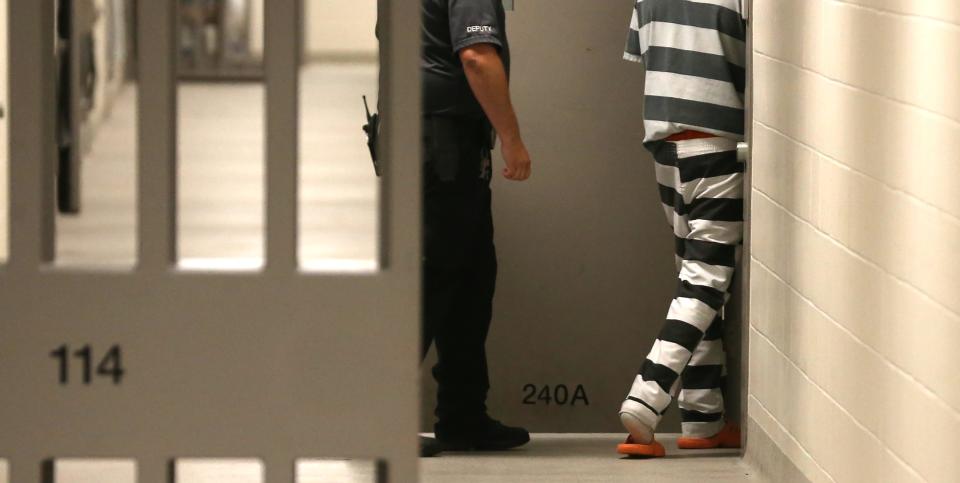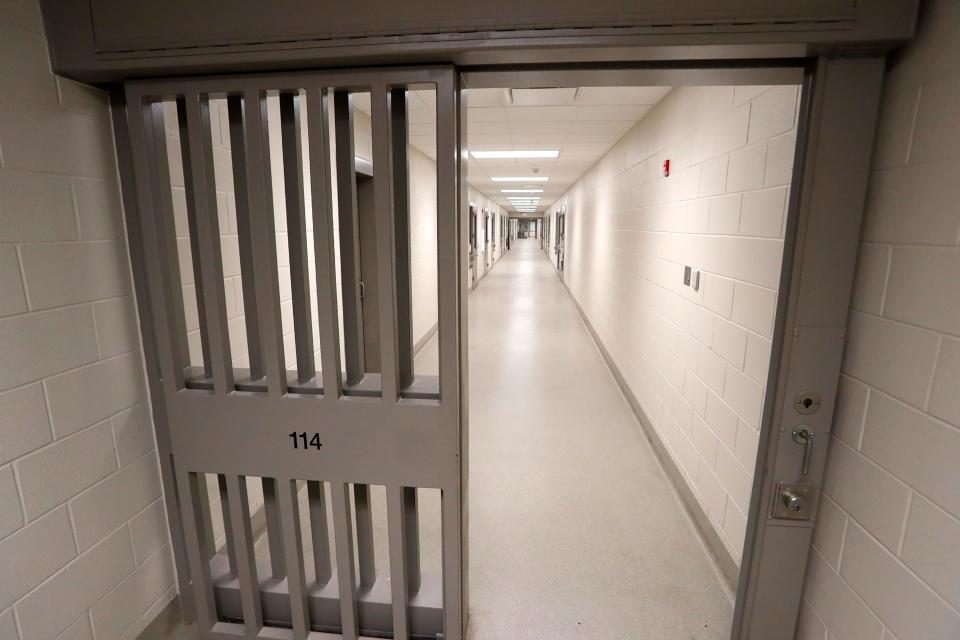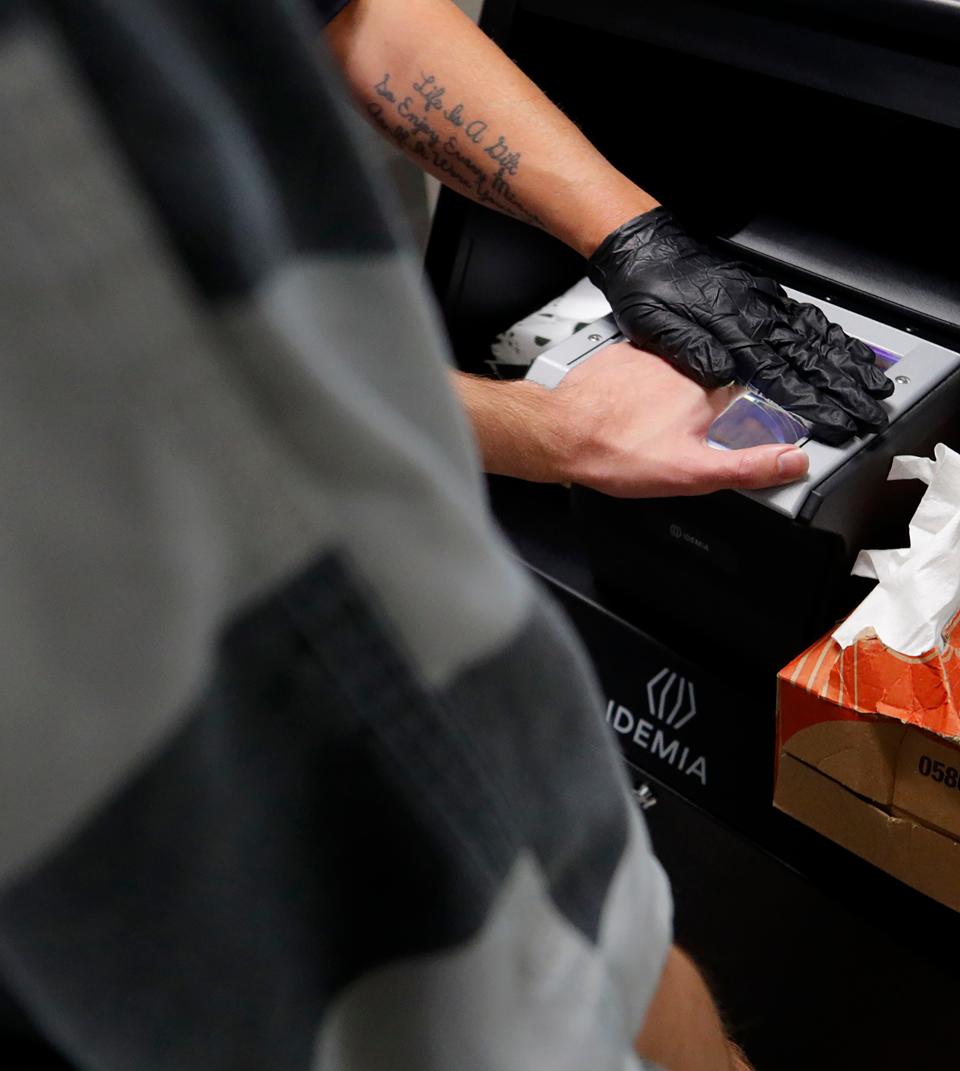Louisville's jail has seen suicides, overdose deaths; Oldham County's hasn’t. Here’s why.
This story discusses suicide and mental health issues. If you're in crisis, help is available: Call the national 988 Suicide and Crisis Lifeline by dialing 988 or chatting online.
If you or someone you know is in crisis, you can get help through the 24/7 Crisis Text Line by texting HOME to 741741. Chat with someone online at crisistextline.org.
Set amid green fields and farmland on a two-lane country highway outside La Grange, the Oldham County Detention Center feels a world away from downtown Louisville’s troubled, outdated jail 24 miles to the southeast.
Inside the lobby’s doors, a bookshelf next to video-call booths is piled high with stuffed animals for visiting children.
Unlike Louisville’s jail, which at times has been so crowded that people have to sleep on the floor and under tables, everybody at Oldham County’s jail has a bed.
Those held in isolation — and at greater risk of suicide — are monitored by camera feeds instead of relying on passing guards and incarcerated work aides, as is the case in Louisville.

And unlike Louisville’s jail, which has had six suicides and five overdose deaths since November 2021, the Oldham County facility has seen just one overdose death and no suicides in the five years since it opened.
In a 456-page report on Louisville’s jail ordered by Metro Council and released in April, report author and former FBI agent David Beyer held up the Oldham County Detention Center as an example of a new, modern and well-functioning facility where deaths from suicides and overdoes are not the norm.
While Oldham County’s jail has roughly a quarter of the population of the 1,200 plus people currently incarcerated by the Louisville Metro Department of Corrections, it has not seen a proportional share of deaths.
To Beyer, the shortcomings of Louisville’s facility — which is made up of a retrofitted office building and a five-decade-old section of cells across the street — created an unsafe environment for those incarcerated and an unhealthy work environment for officers tasked with watching over them.
In his report, he urged the city to build a new facility, like Oldham County did.
“In summary, there have been far too many studies, reports and multitudes of conversations about the need for a new jail,” he wrote in the report. “Continued failure to address this issue may have dire consequences both financially and reputationally for Louisville.”

Speaking before a Metro Council Government Oversight and Audit Committee meeting in October, Beyer was even more blunt, comparing trying to fix Louisville’s jail to spending money repairing a car with 280,000 miles on it that’s “ready to die.”
He also warned the committee that if the city failed to build a new jail on its own, it could be forced to build a more expensive facility under a federal consent decree.
Community activists have stood against a new jail, saying the construction of a new facility will only put more pressure on police and prosecutors to fill it.
While campaigning for office last year, Mayor Craig Greenberg said a new jail should not be a priority for Metro Government. In a statement to The Courier Journal, mayor's office spokesperson Kevin Trager said the city has "no current plans to build a new jail" and remains focused on reforms at the current facility.
LMDC a 'maze of corridors'
The Beyer report was blistering in its criticism of LMDC’s downtown Louisville facility, which occupies the former Metropolitan Sewer District headquarters at South Sixth and Liberty streets and two floors above the Hall of Justice building across the street.
It is a “maze of corridors’” that is “full of blind spots,” he wrote.
Dorms are frequently overcrowded, with people forced to sleep on the floor.
People in isolation are checked on by passing guards or by fellow prisoners tasked with watching them.
Those fellow prisoners, he wrote, were sometimes “lackadaisical” and seen sleeping.
Guards in the mental health section of the jail, Beyer wrote, were often watching YouTube videos.
While cameras are trained on other areas, Beyer said officers watching the feeds in “extremely dark and dingy” control rooms were unable display all the cameras they were responsible for at one time.
Mental health care facilities in the early 1900s, Beyer stated, were “in many instances” superior to the bleak cells LMDC provides.
“If you don’t have a mental health issue when you come in here, you’ll leave with one,” said one incarcerated person anonymously quoted in the report.
Beyer added: “Like the living conditions for persons incarcerated, the working conditions at LMDC are not conducive to one’s mental health.”
'A well-maintained facility'
At the Oldham County Detention Center, control rooms viewed by The Courier Journal on a recent tour were calm and spacious, with large screens clearly displaying video feeds from around the facility, including cameras stationed in every single-person cell.
When officers see an emergency on camera — an attempted suicide, an overdose or another medical crisis — they can respond within 20 to 30 seconds, said Jeff Tindall, the Oldham County jailer.
“Cameras are huge, because we need to have as many eyes on everything that’s going on as possible,” he said.
Single-person cells have repeatedly proved to be deadly at Louisville’s jail. With prisoners often only observed when a guard is performing checks, people attempting suicide can be long dead by the time they are found.

While many modern jails and prisons feature “direct-supervision” designs — where cells surround common areas where officers are also stationed — the Oldham County jail does not, instead leaning on technology to keep eyes on people in custody.
Laid out on a single floor with a simple design, officers do not have to negotiate elevators or stairs to respond to incidents, as they must in Louisville. While the Beyer report noted there are parts of Louisville’s jail where radios do not work, at Oldham County’s jail, radio transmissions are passed along seamlessly.
Prisoners in Oldham County isolation cells are also allowed to have television sets to pass the time — as long as they are not in isolation as a result of discipline.
Incarcerated people can also get hand-held devices that allow them to text their families for a 10-cent per text fee, of which the jail takes a cut.
Tindall is eyeing a section of land just beyond the jail’s eastern fence to turn into a garden for prisoners to tend.

Of the 36 deputies at his jail, Tindall said five or six worked at LMDC in the past.
“This here is by far a greater work environment than it is down there,” one Oldham County Detention Center deputy who previously worked at LMDC told The Courier Journal. “Here, we work together very well. Down there, you’re kind of by yourself.”
Like Beyer, Tindall — who considers LMDC to be a sister facility — believes Louisville needs to build a new jail from the ground up.“Everybody that’s worked inside of [Louisville’s] jail knows that they need a new jail,” he said.
“You use the tools that have been given to you to run a well-maintained facility,” Tindall said. “And fortunately for me, that’s what we have here.”
While the Beyer report included an entire section on Oldham County’s jail, it also highlighted the Fayette County Detention Center in Lexington, which, despite having a prisoner population roughly equal to LMDC, has seen only two suicides since 2018 and no overdose deaths, according to the report.

Like the Oldham County Detention Center, the Fayette County jail was built for incarceration. It opened in 2000 and features a direct supervision design.
With only one overdose death and no suicides in 26 years, Oldham County’s safety record extends beyond its current, new facility to when the jail was in downtown La Grange and lacked features like cameras in single-person cells.
Tindall, who has worked at the jail since 1997, attributed that success to luck and a good staff.
The county built the detention center at a cost of $24 million, Tindall said, replacing a smaller, older facility in downtown La Grange. Most people held at the 332-bed detention center are federal prisoners, and the county gets paid by the government for the service.
In his report, Beyer wrote that Oldham County’s jail showed “it is possible to substantially reduce or prevent overdoses with proper leadership and protocols in place that are followed.”
LMDC says changes are in progress
Jerry Collins, who took over as Metro Corrections' director last April, advocated for a new jail during the waning days of former Mayor Greg Fischer’s administration.
Now, however, he says he’s focused on making the current facility the best it can be, noting that any decision on a new facility is out of his hands.
“That’s kind of where our mind has to be: ... Not thinking about rainbows and unicorns in the future. We got to deal with what we have right now,” he told The Courier Journal in an interview. “If you start thinking about the future, as far as the things you’re talking about the facility, we’re going to miss the things that are challenges right now. Folks above me will have those talks. But my job is to run this facility the best way we can possible and really thinking outside the box on how we do that.”
Collins said the jail has “answered 99% of the Beyer report” and that changes were either on the way or coming.
In recent weeks, the jail has started installing cameras in the first of 150 single-person cells. Funds for the cameras were approved by Metro Council last year, but Collins said their arrival was delayed by supply-chain issues. He anticipates it will take several months to install all of them.
“Best money they’ll ever spend,” said the Oldham County jail’s chief deputy Jessica Childers.
One part of the Louisville jail — a general population section atop the Hall of Justice across the street from the “main jail” — has been transformed into a more modern direct supervision model where guards can have eyes on dorm rooms from a central location at all times, Collins said. However, that is the only area of the jail that could easily be reconfigured like that.
Additionally, Collins said he is implementing a culture change at LMDC, and since he has taken over, 13 officers have been either terminated or resigned in lieu of termination for misconduct.
More: Harassment, coercion and bullying: Louisville jail officers describe a 'toxic' workplace
“One of the things we had to do was really have a fair disciplinary matrix and start holding folks accountable,” he told The Courier Journal. “Because we want professionals here, we want to get paid as professionals. So, you got to hold people accountable as professionals.”
Other changes include:
Covering bars in single-person cells to prevent tie-off points for suicides by hanging.
Introducing a “masters-level” mental health evaluation for those entering the jail, enhancing screening.
Installing the overdose-reversing drug Narcan in every dorm, which Collins says has saved lives.
Putting in 15 suicide-resistant cells.
Offering Suboxone, a drug used to treat opioid use disorder, as a treatment option for those going through opioid withdrawal.
Increasing drug interception capabilities by using body scanners, drug-sniffing dogs and expanding the jail’s intelligence team.
Creating a suicide review team led by the jail’s staff psychologist, who was brought on at the start of Collins’ tenure.
Even if the city decided to build a new jail today, Collins said, it would take two to three years for a facility to open, making reforms within the existing buildings a necessity.
Collins said some things highlighted in the Beyer report — like how prisoners were not allowed any recreational time in the gym because of staffing issues — have already been addressed.
He also pushed back on the notion featured prominently in the Beyer report that officers cannot currently view all the cameras they are assigned.
'A good, beautiful building won't make a difference'
Opponents say a new jail will not address the issues behind the deaths at LMDC and would put pressure on the city to fill the jail.
“I get that. It’s nicer, it’s more aesthetically pleasing. But even Beyer mentions in his report, if you don’t have the right type of people in there, the right type of services, a good, beautiful building won’t make a difference,” said Kungu Njuguna, a policy strategist with the ACLU of Kentucky.
Instead, Njuguna said, the focus should be on keeping people out of jail and stopping prosecutors and judges from putting bonds on people.
Many of those who have died since November 2021 have been homeless, without the means to pay relatively low bonds. Some were picked up on low-level charges related to loitering and panhandling.
The last death LMDC identified as a suicide was that of 28-year-old Miguel Gudiño Resendiz on May 28. He was held at LMDC on a $500 cash bond for an assault charge. Court records listed an address for him, and he told a judge he worked as a painter, but he remained incarcerated for more than a week before his death.
Reviewing LMDC’s recently created jail population dashboard, as of June 21, there were 21 people in custody with bonds of $500 or less.
Four have been held between a month and three months; one has been held between six months and a year.
Of people with bonds between $1,000 and $5,000, four have been held for over a year.
“Building a new jail is not what we need in this city,” Njuguna said.
Reach reporter Josh Wood at jwood@courier-journal.com and on Twitter at @JWoodJourno
This article originally appeared on Louisville Courier Journal: Oldham County modern jail is a world away from Louisville facility

